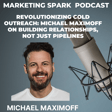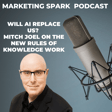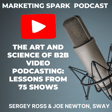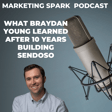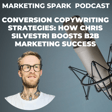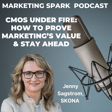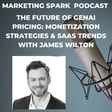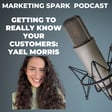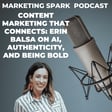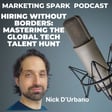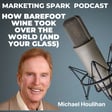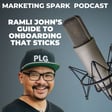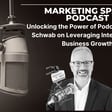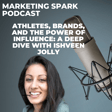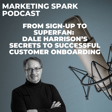Become a Creator today!Start creating today - Share your story with the world!
Start for free
00:00:00
00:00:01

How Marketers Can Escape the MQL Hamster Wheel
Many B2B marketers are throttled by the need to generate MQLs.
Their campaigns and activities are measured by how many email addresses are collected and fed to an army of business development and sales reps.
Nelson Gilliat believes there's a better way.
The "Buyer-centric revenue" model allows marketers to do good and creative marketing that drives brand awareness and generates customer interest in your products.
At the same time, the buyer-centric revenue model eliminates a lot of the prospecting done by B2B SaaS companies.
It's cold outreach and cold-calling that bother prospects rather than engage and educate.
Nelson is the author of "Death of the SDR: Birth of Buyer Centric Revenue"
Transcript
Constraints of Traditional Marketing Models
00:00:06
Speaker
Hi, it's Mark Evans, and you're listening to Marketing Spark. In many respects, marketers operate in straitjackets. It's things like MQLs, gated content, webinars designed to collect emails so VDRs can cold call prospects.
00:00:22
Speaker
Marketers use these techniques and channels because, well, everyone else uses them. It's challenging to take a different approach because they appear to be safe and less risky. But Nelson Gileot believes the predictable revenue model is outdated and harmful. He believes marketers need to leverage a more buyer-friendly model rather than wasting time with marketing that actually turns off buyers. Welcome to Marketing Spark, Nelson.
00:00:49
Speaker
Yeah, Mark. Thanks so much for having me. Great to be here. Why don't we start with an obvious question.
Critique and Alternatives to Predictable Revenue
00:00:56
Speaker
What is the predictable revenue model and why is it outdated and harmful?
00:01:02
Speaker
You know, I wrote this book about two months ago called the death of the SDR and the birth of biocentric revenue where I challenged the particular revenue model and I introduced the biocentric revenue model as a better alternative. And I think you introduced the kind of the problems pretty well where in marketing today, a lot of people are frustrated. They're having less productive and fulfilling careers because they're in this straight jacket where they're forced to do things that they don't want to do and they know they shouldn't do. And they're prevented from doing the things that they want to do
00:01:31
Speaker
And they know that works. And I think that the source of these frustrations, the source of the problems within B2B marketing, why marketers are on this, they call it the MQL hamster wheel, why they, all, all their budget and resources kind of has to be facilitating a lot of bad marketing, essentially. And, you know, they're stuck between good marketing and bad marketing is stuck between old marketing and modern marketing.
Historical Context of Current Marketing Playbooks
00:01:52
Speaker
And they're kind of in two worlds.
00:01:53
Speaker
And I think the root source of that bad marketing and the old marketing is the predictive revenue model. And that's what marketers need to sort of liberate themselves from as well as sellers. They're both kind of jammed in it together. And essentially, the predictive revenue model is the B2B marketing and sales playbook.
00:02:08
Speaker
that most B2B companies run on to some extent. I say to some extent because they don't take it straight. They're not only just doing the predictive revenue model. Again, there's a mixture. Companies can't just run on that model today. But essentially, this playbook was popularized in 2011 by Aaron Ross in his book, Predictive Revenue. But it is based on his time in the early 2000s at Salesforce. And this is sort of when the predictive revenue kind of came about in practice, was the late 90s, early 2000s. So
00:02:34
Speaker
Just keep that context in mind as we go through that today marketers and sellers and companies are running this playbook from the late 90s, early 2000s to some extent. Still today, despite all the changes we know with buyer preferences and in technology and what marketing can do nowadays. And so essentially what the Pareto Revenue Model calls for is two things. One is a marketing thing, the second is a sales thing.
00:02:56
Speaker
The marketing thing is it calls for prospecting and it calls for prospecting to be done full-time by SDRs and no longer by sales. Sales needs to do it. And then Ross came along and said, that doesn't make any sense. Let's have SDRs do it. So that's the marketing thing. And marketing has to support SDRs, right? Essentially with SDRs or prospecting thing, it's a marketing, not a sales thing. It's to generate appointments for sales. So we'll talk about that.
00:03:20
Speaker
The second thing that particular revenue talks about is a sales thing. So we'll leave that aside for the moment, because this is a marketing audience, but just so people know, it's the sales assembly line, a seller specialization or buyer handoffs, where you have predominantly the AE slash CSM split. So a seller that helps with the initial sale, then a seller that helps with the expansion retention. In practice, that's often further subdivided where you have the AE and then the sales engineer and then the CSM, the account manager, et cetera, et cetera.
00:03:47
Speaker
And to some extent that does harm marketers, you know down funnel I think you know if markers are going to hold themselves accountable to revenue and conversion rates and sales cycle, and not only to the initial sale but also to expansion retention, that if your sales comrades aren't doing well then
00:04:02
Speaker
you know, that's going to affect you. But for the moment, I think the crux of the problems B2B today are prospecting in our SDRs, which is why the thrust of my book and why my title of my book challenges that, and why I think that is really why markers are chiefly suffering
Pressure on Marketers to Generate MQLs
00:04:18
Speaker
today. So I'll kind of pause there with that kind of swipe at predictable revenue and see if there's any reaction before kind of going on.
00:04:26
Speaker
So I'm sure that a lot of marketers who are listening to this podcast are probably nodding their heads in violent agreement because the reality is we are on a hamster wheel. A lot of marketers have to produce those MQLs. And that is for better or worse, the key metric that their performance is assessed upon. And they know there's a better way. They know that experimenting with different channels and different kinds of tools
00:04:54
Speaker
is a more creative and more interesting way to work. But at the same time, there's a lot of pressure on marketers to perform. And I put that in quotation marks. That's why generating leads and feeding them to sales and BDRs and SDRs is the common approach. How do marketers break out of that? How do they do prospecting that is more efficient, more productive and more successful?
Reimagining SDR Roles and Responsibilities
00:05:18
Speaker
Long story short, I think that you should stop doing prospecting altogether and that you should just do good marketing or good modern marketing. And basically the way I see it, prospecting is the worst kind of marketing where it's essentially you're annoying buyers with telemarketing, email spam and LinkedIn spam to get them to speak to sales. And that's essentially what the SDRs are doing. That's what prospecting is. And so today companies have a mixture between prospecting or this old kind of worst type of marketing and then modern demand gen. And so I see that SDRs and demand gen
00:05:47
Speaker
are competing against each other for budget and resources and who's doing the right good type of marketing, who's doing the wrong bad type of marketing or the outdated type of marketing. And unfortunately, a lot of marketers and demand gen have to support the SDRs. While demand gen are doing all these good things like content and social media marketing and ads and events and all this good stuff, at the same time, they have to support the SDRs to do their thing. And so that's where a lot of marketers are frustrated.
00:06:11
Speaker
and are on this MQL hamster wheel. So what an MQL hamster wheel is and what MQL really is, it is marketing or demand gen is forced to constantly generate a high volume of contact information of uninterested buyers so that the SDRs can go and annoy them with prospecting.
00:06:29
Speaker
And that is why marketers have to either buy this contact information through content syndication or list purchases or whatever, or they have to gate their content, which you know we know is terrible, you know, and produce, you know, crap content, a high quantity of it, just to try to get someone's email or the telephone number, you know, ebook downloads and whatnot, or
00:06:49
Speaker
you're hosting events, webinars or panels or summits just to get someone's contact information so that then you then put them into an SDR cadence, which is awful. You're trying to woo buyers by putting out content only that you can then hit them over the head with
00:07:05
Speaker
an SDR sequence so they get turned off and they tune out and they don't keep coming back for more. So it's really, really bad. And that is why Marker is often held accountable to this MQL thing because they have to feed the SDR org. They have to feed that sort of machine.
00:07:24
Speaker
as opposed to marketers being held accountable to the metrics that really matter, like revenue and qualified pipeline, the number of sales, qualified opportunities and cost per opportunity, conversion rate, sales cycle, cost per acquisition, cost per acquisition payback period, all that type of stuff. If marketers were to be held accountable to that, it would really expose how bad prospecting is and how bad, you know, SDRs are.
00:07:45
Speaker
And so what I recommend today is like a lot of companies don't realize how bad prospecting SDRs are because they don't distinguish it or separate it from the rest of their marketing efforts. So they blend when they look at like their marketing efforts, they just blend and mash everything together. So they got blended CAC, blended conversion rates, blended this and that. They don't separate it. So then you don't realize how bad things are. And so what I recommend that people do is yeah, you kind of have to separate prospecting from, let's say,
00:08:11
Speaker
website demo requests. The way I see it is like marketing should be trying to woo buyers in the door all the way to requesting a demo.
00:08:19
Speaker
the website to speak to sales. And then at that point, that's the handoff to sales. So marketing automatically qualifies them on the website. Yeah. Then sales enters the picture and not before them. Those are the hot leads. Those are the layups. Those are the efficient and effective marketing and sales efficiency process. Whereas trying to jam junk through the pipeline is not good for marketing. And it's definitely not good for sales, which is one reason why a lot of sellers today are missing their revenue and why there's marketing sales alignment because
00:08:45
Speaker
marketing is producing junk, you know, MQLs and chips stuffing, you know, a high quantity of low quality stuff for the pipeline. And then sales gets caught holding the bag. That's the, that's the whole mystery behind the misalignment. It's all sales wants. It's just good leads, you know, so they can do their sales thing, you know, and sales does not want to be doing marketing. And what I recommend for people to do is.
00:09:04
Speaker
look into your CRM and distinguish leads generated from prospecting from the SDRs versus website demo requests, and then compare that to those metrics. We talked about that matter, like revenue and conversion rates and sales cycle and CAC. And then you can see where you're getting the results from, which side your bread is butted on. And then when you factor in the difference in resources that you're putting into SDRs and prospecting versus the resources you're putting into demand gen,
00:09:30
Speaker
And SDRs are very time capital and labor intensive. It's no joke. That's why sometimes people outsource that, which doesn't make it any better. I just think it makes it say less harmful. But it's like so much focus and resources diverted away from good modern marketing and into SDRs. And so I think when you factor that in, plus you factor in the fact that buyers get turned off and tune out to the SDR outreach and
00:09:51
Speaker
You can capture some of that in your CRM where it's like taking off your list, unsubscribe, negative reaction, whatnot. But a lot of it you don't see, you know, how much, how much annoying outreach do you get that you don't really reply to and get, get turned off to. So there's that cost. Then there's the opportunity costs, right. Of, of not doing good modern marketing or demand gen.
Introducing the Biocentric Model
00:10:11
Speaker
You know, I think for a lot of marketers who want to break free and sort of be able to have the freedom and the resources to do good modern marketing, you're going to have to challenge the root cause, which is not the MQL.
00:10:21
Speaker
which is not the attribution craze, which is not the lead gen model, which is just a way of saying like, that's just the lead gen model is just the process of generating MQLs, but fundamentally upstream, the root cause of all of it is the particular revenue model, which still demands today that we have SDRs, we still do prospecting. And so if you get rid of prospecting, you get rid of SDRs, you get rid of the particular revenue model, you then free yourself to be able to do the good modern marketing, to have like demand gen to let it do its thing and run all those good plays.
00:10:51
Speaker
There's a lot to unpack from that answer. Let me get some quick answers to a few basic questions, things that you brought up. What's good marketing and what's bad marketing?
00:11:02
Speaker
The standard for good marketing is basically you look at revenue and qualified pipeline and those metrics that matter like conversion rates and sales cycle, CAC and CAC payback. That's how you determine marketing efficiency as well as sales efficiency. So they should have very similar metrics, marketing and sales to kind of keep them both at the hip and aligned. Basically what good marketing will look like instead, because again, prospecting all that is, is telemarketing, email spam and LinkedIn spam.
00:11:30
Speaker
and sometimes direct mail or gift cards in exchange for demo or bribery, I think. But what good marketing looks like nowadays, primarily, given the change in buyer preferences and technology is
00:11:40
Speaker
essentially the big play today is really good content marketing with really good distribution. And so, you know, whether that content is, you know, audio written or visual or some mashup of the two, it's entertaining, it's educational, it's, you know, you're basically getting your message out there in front of your audience and then distributing that wherever your audience is and all, you know, whether that's LinkedIn organic, whether that's to your email list of opt-ins on, you know, YouTube, or you're putting paid ads behind it,
00:12:09
Speaker
to distribute that content, whatever, you're getting it out there. All these social platforms that didn't exist 10 or 15 years ago, we have to keep in mind that a lot of the plays that we're able to do today didn't exist a while ago when predictive revenue was around. And so that's a big change. And so what markers can do today where it's like, for example, you have a podcast and then you invite your audience on, you invite influencers on, so you're doing co-marketing.
00:12:30
Speaker
influencer marketing, you then distribute that content on social media, on LinkedIn, and then, you know, you tag people and then you get the network effect and all that type of stuff. And you have got this, the podcast is a great content pillar. And then your guest podcasting. So you're on other people's podcasts with audience that they have doing events and you're doing summits and roundtables and panels and fireside chats and whatnot. And you're bringing in speakers and influencers or, you know, again, you're co-creating this type of content. You know, maybe you have live audience and Q and A, so you're getting your,
00:12:58
Speaker
getting the folks that you want involved. Maybe you're kind of creating a little community where people keep come back for more and more content, your expertise, you know, your thought leadership, you know, just, and they like you, they like your, your, maybe you're also, some of your content is humorous or whatever. And it, you know, it helps them to level up in their profession. That's how they become aware of you. That's how they then consider you. They'll check you out. They'll look at your company. They'll, they'll come to your website. They'll have a play around. You know, recently I had no idea what metadata.io was, but they had a summit like, you know, called demand recently.
00:13:27
Speaker
I didn't know what they did. And then I attended the summit, really enjoyed it. They had a bunch of good talks. And then I checked out their website and I was like, Oh, okay. Gotchas. Now I know what you do. And if I ever have that need, I'll come to you and I'm not going to check out your competitors. I'd really like you guys. And I keep seeing your content. You know, I keep, I get your ads on Facebook or on LinkedIn and I've attended your event and I like your stuff on LinkedIn organic. And so that's just like, that's how basically B2B buyers will talk to. And maybe I'll talk to a few people about metadata that I owe in my network. You know, it's stuff like that.
00:13:57
Speaker
is what marketing can do. And also the website is a 24 seven seller that marketing owns. So it's like buyers want to do their own research. They want to basically carry themselves pretty far along their buying journey. And maybe at the end, that's when they want to speak to sales. If they need to, sometimes they just hit the buy button or whatever, but if they need sales help, then they ask for sales as help. And then that's where marketing comes in on the website. And then it can say, Hey, you want to speak to sales yet, which is answer these few qualifying questions. Great on the website. Here you go. Here's the seller's calendar.
00:14:25
Speaker
and that all that information that the buyer needs is on the website. So you put the demo recording, you put the pricing or at least ballpark pricing, you put the FAQ, like all that type of stuff you just put out there in the website because sometimes the buyer isn't ready to kind of go through the whole song and dance with sales, but they just want that information. So as long as you make that accessible on the website and help educate the buyer,
00:14:45
Speaker
almost like in B2C where marketing is responsible for the entire buyer's journey is how marketers need to kind of sort of work today where it's like, yes, we have sales and we support sales, but we also need to give the buyer as much information as that they need. So if and when they do need sales, they're like pretty far along and it's a slam dunk.
00:15:03
Speaker
So the other question I wanted to ask you is the impact on marketing and marketers when companies do things like gated content or webinars and people do provide their email addresses. In some cases, almost immediately, the person who downloaded the asset or attended the webinar will get an email or a call from an SDR
00:15:28
Speaker
essentially saying, Hey, I noticed that you did this. And as a result, I wanted to see if you wanted to book a demo. The way that I look at it, that's just an expression of interest, like attending a webinars. Okay. A curious, or attending an events like metadata. It's not an intent to purchase. And what is the, how does it make marketers feel and how does it make consumers feel? Cause increasingly, I think a lot of consumers are annoyed by those cold call outreach.
00:15:52
Speaker
Yeah. So where we are today is that we have kind of like a mashup, right? Of both good marketing and bad marketing. And so where the SDRs or the prospecting often comes in today is that marketing will do all this stuff to butter up and warm up prospects and put out this good content. And then, then you kind of sick decks, let the dogs loose or something like that. And you kind of stick the SDRs on them to annoy these buyers.
00:16:13
Speaker
And I think that's so awful. It's like, you know, you go to a bar, right? And there's all these guys and you're trying to woo the girl in the bar. And so you put on the charm, you let her know what you're about. And at the end, you know, when she starts liking you, then you're a jerk to her at the end. And it's like, you wonder why you never hear back or, you know, you weren't successful. And I think it's, it's like that, that's a really, that's really terrible. And so what's happening today is that Mark will do all this stuff and then so-called lead intent or lead scoring or ABM. There's just a fancy way of saying, Hey, which of the,
00:16:41
Speaker
uninterested buyers? Are we going to prioritize based on their content consumption? Who's coming to our website? Who's checking out our reviews? Who's coming to our events? Who's downloaded our content? And then based off that, who are we going to annoy? Rather than saying, okay, we're seeing who's doing what, that's giving us feedback on our marketing. We understand which of our content is hot,
00:17:02
Speaker
and what buyers are digging good, letting these buyers continue to come back from a content, continue to provide value. They'll eventually come and hit that. If they want to speak to sales, they will request to speak to sales and maybe they'll share with other people. You're not turning them off and you're not trying to force them prematurely.
00:17:18
Speaker
And the thing is like prematurely into a buying cycle when they're not interested in buying because not only will you turn them off and they'll tune out and they'll stop consuming your content and they'll say, ah, this is just a thinly veiled sales pitch. It's also, even if you've managed to finagle them into a meeting, you're wasting sales as time because this person isn't a buying cycle. They're just like, you just pressured them, you know, they'll just kick the tires a little bit, uh, or they didn't know how to say no to the SDR. And so you basically then give sales junk and that, you know, it's like,
00:17:42
Speaker
you know, this person isn't actually interested in buying at all, they just want a demo, which they probably could have just gone, or they should have just gone the website if they just wanted a demo. Yeah, I would say this kind of practice where it's so counterproductive. And it's, it's a shame because, you know, you're doing all this hard, good work marketers only for the SDRs to come in and kind of ruin it at the end. And not to mention, it's like, again, it's like,
00:18:03
Speaker
SDRs are really expensive to support them and to hire them and to train them to coach tools and it's just and they turn over a lot and there's a cost of that and like it's a so one of the things I recommend to kind of where people can kind of go from here ultimately I think that
00:18:19
Speaker
SDR should be repurposed into other marketing activities that are more productive and fulfilling. And so I would transition your SDRs to kind of be like entry-level general marketing generalists that help with like content marketing and social media and demand general product marketing, you know, or ops and stuff like that. Like just have them do other marketing tasks. And that's kind of essentially how I recommend that people transition. Cause I don't recommend that you let them go overnight.
00:18:45
Speaker
you know, that is a waste, you know, you've got talent, you've got really good talent, you just need to unlock that talent and get more productive use out of them. And so just have them do better marketing. And there's a process that I kind of outlined to people to kind of go from A to B and to help with that transition.
00:19:00
Speaker
To run with your bar analogy, it's like meeting someone at a bar, you say hello, they say hello back, and then you say, hey, do you want to get married? That's kind of the way it is these days, the kind of the way it feels. Let's shift gears and talk about the biocentric revenue model. I'm really curious about why is it better? How is it different? And as important, how do
00:19:23
Speaker
companies and marketers transition from the traditional, predictable revenue model to a buyer centric revenue model. And the one thing I will add before you answer is that there's a lot of chatter on LinkedIn and other places about being customer centric, knowing your customers inside out. A lot of it is talk more than walk. You know, a lot of marketers say, Hey, it's important to know your customers, but then they never talk to them or even listen to sales calls. So I will add that, but just to circle back
00:19:52
Speaker
So what is the biocentric model and how do you get started with it? How do you make it happen? So the biocentric revenue model basically sunsets prospecting in favor of demand gen or just proper good modern marketing. And so you sunset SDRs and you sunset prospecting. And then it also sunsets the buyer hand officer seller specialization or sales assembly line, all those subdivision of sales where you have stunted sellers and then this awful
00:20:18
Speaker
you know, ring around the rosy for buyers and bloated sales orgs in favor of a one-to-one buyer-seller relationship where a seller is a full and complete seller and has full ownership over the buyer relationship and can loop in internal folks as and when needed, whether it's like technical folks to help with expertise or someone from implementation to customize the product. But fundamentally, there's one seller for one relationship and that's what sales is all about, building relationships. So you'll have a more efficacious seller
00:20:43
Speaker
have a happier buyer and you have a leaner sales org. There's two other things I talk about in my book that's related to the buyer-centric revenue that affects sales more. But again, I think if market sales are going to be at the hip and both be successful, if your sales team is suffering, you're going to suffer. And I think that sales is suffering from two other woes, which are quotas and commissions, which force them to basically is a, you know, pressures them and to do basically pressure the buyer, which is a lose, lose. And so just be aware of that marketers that like oftentimes
00:21:10
Speaker
Even if marketing has the freedom to do good marketing, if your sales leader is using quotas and commissions or sales assembly line, that's going to try to pressure marketers to put junk through the funnel. That's something that marketers really need to understand and be aware of.
00:21:26
Speaker
It's not just that marketing is in its own world and has its own
Challenges of Sales Quotas and Commissions
00:21:30
Speaker
problems. It's that sales problems will bleed into marketing's problems. And so, yes, you will encounter resistance, let's say, from sales sometimes because the sales leader is just like, I just need to keep my sellers busy with junk. So give me junk and you don't want that. I called it the biocentric revenue model because
00:21:47
Speaker
particular revenue model is so anti-buyer. It's so misaligned with how buyers want to be marketed to and sold to, and that if marketing and sales want to be successful, we have to conform to the bubble buyer. Since that's not the case, we've set up marketing sales for failure and not success, which is why marketing sales are suffering today. There's high turnover, low tenure, low productivity, low performance, low job satisfaction across the board. There's a lot of frustration, no freedom to do the stuff that we want to do and can do and should do.
00:22:13
Speaker
You know, in terms of helping people transition, I recommend there's a, there's like a three or four step process. So obviously like, you know, grab, hopefully grab my book. So you have more context around it and the theory and whatnot. And I also kind of lay this stuff all out. So with the theory, then the first step is to gather the data at your own company. So look into your CRM do that kind of test where you separate the leads from SDRs and prospecting from demand gen leads or website demo request.
00:22:39
Speaker
look to revenue and conversion rates and sales cycle, all those metrics that matter. First calculate that, then calculate the resources that go into SDRs versus the resources that go into DemandGen.
00:22:51
Speaker
consider the harm that it does to buyers and to your brand, doing that prospecting of annoying buyers like that. Then use that data and take this theory and propose an experiment to the board or to the CEO and to say, hey, here's the harm of what's going on. And here's the solution. Like here's what I want to do instead. So it's really important when you point out the bad, you also show
00:23:14
Speaker
Hey, here's what I want to do instead. So every CEO is like, great. I get, you know, I get how bad it is. What's the solution? So don't be a complainer and just say, Hey, we think that's just really bad or the prospecting is really bad, but we got nothing to do better than that. They're going to be like, you got to come back with something, show them the good market, the good modern market and what you want to do instead, but you need the freedom and the resources to do it. And that, that will produce better outcomes of what the business really wants, which is revenue and qualified pipeline and all that type of stuff and better win wage and better sales cycles, et cetera.
00:23:40
Speaker
propose a pilot, gather your allies to propose this pilot from marketing, from sales, from finance, from operations. So make sure you kind of have a tight case and propose that to the CEO, propose that to the board, propose that to the CMO or to whoever you're reporting into. Propose a two-step experiment. And the first step is to automate demo request qualification and demo scheduling right on the website. So rather than having an SDR manually qualify buyers,
00:24:07
Speaker
um you know and then do this whole ring around the rosy and again these are people who are knocking on the door so you got people who are knocking on the door saying hey i want to speak to sales and then you don't answer that for a while and you give them an awful experience and then you wonder why they never make it into the house and stay as a customer and there's a lot of stats out there it's like 70 of those buyers if they have an sdr manually qualifying them never actually make it to sales so it's like this is the high intent like
00:24:28
Speaker
bottom juicy stuff. So this is a great win, guys. So automate that on the website. You can easily do it on the website. So propose that as a first experiment. And then meanwhile, repurpose those SDRs who are doing that, to whatever extent they were, to other productive marketing activities. They'll be thrilled because that's the more... SDRs do not want to be SDRs. They hate it. They can't wait to escape. They would be so thrilled to do that. In addition, give them quarter relief. In other words, pay them the full amount that they're supposed to get paid, their OTE,
00:24:56
Speaker
and give them quite a relief and you know just say hey this is an experiment we're going to run this and then run this for maybe a few like one two three sales cycles so that you can then see the results and track it over time do that so whether that's three six nine months whatever and then boom okay great you'll see we're going to automate that that's the low hanging fruit
00:25:13
Speaker
And now we've repurposed SDRs to do good marketing. So now they're helping out with good marketing, they're doing more content, they're doing more demand gen, they're doing more social product marketing, whatever, helping out with events, helping out with ads, you know, the paid ads on, you know, all the different channels that you can do to get your message out there, whatever. The second part of that experiment is to gradually reduce their prospecting outreach. So gradually reduce
00:25:34
Speaker
their telemarketing, their email spam and the LinkedIn spam by 25% increments. So if you're supposed to make 100 calls a day, which is kind of typical, you have them make 75 calls a day. And then meanwhile, gradually repurpose them to other marketing activities and then give them quarter relief. Again, they'll be thrilled. And then you're helping to do more good marketing and reducing the harm of the bad marketing.
00:25:57
Speaker
and then do this for a few sales cycles and then continue to do that until you no longer basically until you fully sunset prospecting in favor of good, proper modern marketing. And you'll see the revenue will go up, your conversion rates will improve, your sales cycles will improve, all those metrics, your cost per acquisition.
00:26:14
Speaker
will improve and then you know that's there you go the proof is in the pudding and then you kind of have proven you know that that's the that's that ought to be done and meanwhile you rescue your SGRs you help them really help them find more productive fulfilling careers which again they're trying to do as soon as possible you're just accelerating that.
00:26:30
Speaker
And now you've liberated yourself to have the freedom and the resources to do the good marketing, to get off the MQL hamster wheel, to only produce website demo requests that you automatically qualify, to be able to do with the content plays that you want to do in the podcast and the thought leadership and LinkedIn organic and the paid ads and all the different channels and the events and all this stuff.
00:26:49
Speaker
And you can do more creative marketing. So a lot of markers can't be creative. You can't do the arts and crafts stuff or do the humor stuff. You can't do all the stuff that really sets you apart because you don't have time for any of that because you're just supposed to kind of be on this MQL hamster wheel. So like, how the hell can you be creative and stand out when you're just having to produce like enough contact information for the SDRs to annoy? I think that that's the sort of ideal that you should be striving for. And that's sort of why it's worth fighting for and why it's worth challenging the particular revenue model and presenting a different model.
00:27:18
Speaker
and trying to test that out and experiment at your own company with it. Now, if your CEO is not about it, if they're just not down for it, then that should tell you something. You can continue to struggle at a company and face an uphill battle and constantly fight to do good marketing, or find folks who are game and who are willing, find companies who are down for you to have the freedom to do good marketing. And those will be the companies that win. Those are going to be the companies that have a massive competitive advantage as they're able to attract
00:27:48
Speaker
better marketing sales talent and attract buyers. If you try to do this stuff and ultimately at the end of the day, you hit a brick wall, then yeah, then that's to be a signal that maybe that company is not for you. I know that was a lot. So I kind of pause there. I kind of went on a rant as I often do. So I'll throw it back to you, Mark.
00:28:06
Speaker
The other question that I wanted to ask you is alignment between marketing and sales. In many cases, they operate in silos. They don't talk to each other. They don't collaborate. They don't share ideas. They don't share information. A lot of information actually sits in the CRM, which sales may access and marketing may feed information too, or there may be an auto feed of information. How do you get
00:28:27
Speaker
marketing and sales to operate as collaborative cohesive units. How do you make sure that they move forward in lockstep so that it's a virtuous circle between marketing and sales. There's sharing of information, there's a sense that they're teammates as opposed to opposing forces and that's the reality for many organizations. How does that happen? How do marketing and sales align so that one plus one equals three?
00:28:53
Speaker
Yeah. So basically once a year, you just go bowling together and it solves everything. That's it. No, no. Yeah. So the answer to that really is again, in the model and the predictive revenue model of misaligns marketing with sales, because again, it, it, it, it, it KPIs, I would say it's quote unquote key performance indicator for marketing is, is producing junk contact information with the SDRs to go and annoy. And then sales is revenue and everything else. And so.
00:29:18
Speaker
there's that natural misalignment. In the buyer-centric revenue model, marketing and sales both have the same goals and KPIs, which is revenue and qualified pipeline, sales opportunities, cost opportunities, sales cycle, conversion rates, CAC, CAC, payback.
00:29:31
Speaker
So then you're both joined at the same hip. You're both aligned in the same metrics and same goals. That's, that's, that's the key right there. And then it's marketing, having the freedom and the resources, um, to do good marketing and drive website demo requests to sales, because sales does not want to do bad manual marketing.
Future Directions and Resources
00:29:47
Speaker
They do not want to do prospect and they don't want to go out and chase buyers. They want to help buyers who want their help to, to evaluate, purchase, implement, be success, um, buy more and renew. So keep in mind folks that like.
00:29:59
Speaker
prospecting is something that sales used to do way back in the day where marketing was unable to connect with buyers. And so they had the sales people basically be like field marketers and go knock on doors. And then eventually that door knocking became telemarketing. Now telemarketing was door knocking 2.0. And then that's kind of where sales would do this kind of bad manual marketing stuff. And today that is no longer the case. And so you can liberate sales also from having to do this prospecting bad manual marketing drudgery, which is what, by the way,
00:30:24
Speaker
I know I've been knocking particular revenue model, but just to give particular model credit where credit is due, they liberated sales from having to do that in addition to the sales job. And so they created the SDRs, which is essentially the marketing function, you know, to do that full time, even though aspiring sellers, anyone who wants to get into sales kind of got stuck into that. So anyone who wants to do sales today has to kind of go through this year of hell and misery, which is still kind of screws over sales. And one of the reasons why sales is still denigrated in sales is very undesirable, I think today in B2B.
00:30:51
Speaker
Sorry, I kind of lost my train of thought there because I kind of went on a tangent. Maybe you can reorient me. Just in terms of making sure that marketing and sales are... Oh, yeah. Yeah, thank you. So, you know, I think that you give marketing the freedom to get those demo requests, and you give these layups, these good leads to sales of people who are actively in buying mode, more likely to buy and buy fast. That's all that sales wants. And then that's kind of where you get the trust, you know, from your from your sales team to be like, yeah, marketing is producing good stuff.
00:31:19
Speaker
And marketing is great. Marketing is crushing it. Fundamentally, then everything else that kind of happens with marketing sales is kind of like icing on the cake where it's like, okay, you meet with your sales team regularly and you get feedback on the leads. And you're hopefully doing some attribution already to kind of know like what marketing should be doing more of. So it's like you're asking buyers, for example, on your website how they heard about you and you're also
00:31:39
Speaker
you may be listening to sales calls or stuff like that, or you're doing qualitative interviews with your buyers, with your customers, you know, your best customers or customers that just bought or people that are speaking to sales people, you know, maybe people that never heard of you to kind of see like, Hey, what's working? What's not? How do we touch up our messaging or positioning or whatever? And then, you know, you're kind of getting feedback from sales as to like, you know, what are the buyers questions? What are the reservations? What are their hesitations? Like, what's kind of
00:31:59
Speaker
Sales is often talking to buyers. And so then that can inform your marketing efforts. That's the icing on the cake. That's the gravy that you can't fundamentally, again, it's the KPIs, it's the metrics and it's the producing good leads for sales. Then it's like, yeah, getting feedback from sales and kind of regularly being in chats with them and things like that. And that's how you'll get marketing and sales alignment, which is so lacking today because that foundation isn't in place because of the particular revenue model.
00:32:23
Speaker
Thanks for all your great insight. This was a really enjoyable and educational conversation. One final question, where can people learn more about you, what you do, and as important your book? You can find me on LinkedIn, Nelson Gilead, and putting out content on this stuff, trying to break it down into some more digestible pieces.
00:32:41
Speaker
They're still rants. They're just rants on, you know, LinkedIn and written form. And then you can find the book on Amazon. Again, it's the death of the SDR and the birth of biocentric revenue. So you can see long form and more context and stuff like that.
00:32:56
Speaker
you can reach out to me if you just kind of want to chat about it. If you're sort of chewing on this and you kind of want to understand like more about the model and, or how to do it at your own company and stuff like that. I've also kind of soft launched a consultancy to help people who kind of want help implementing that model. So I found buyer centric revenue. You know, if you actually need like proper help kind of doing it, I can help with that. But yeah, LinkedIn and you know, that's where we can definitely connect and you know, would be happy to, to chat with anyone.
00:33:25
Speaker
Thanks for listening to another episode of Marketing Spark. If you enjoyed the conversation, leave a review, five stars, of course. Subscribe via Apple Podcasts, Spotify, or your favorite podcast app, and share via social media. To learn more how I help me to be SaaS companies as a fractional CMO, strategic advisor and coach, send an email to mark at marketingspark.co or connect with me on LinkedIn.

